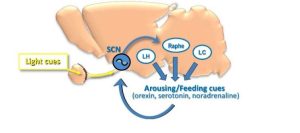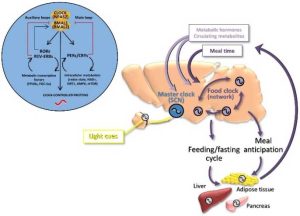Functional links betwen brain clocks and nutritional and arousing cues
Sylvie Raison, Stéphanie Dumont, Patrick Vuillez, Etienne Challet

Presentation
The 1st main aim of the team is to analyse how brain clocks regulate feeding rhythm, food-anticipatory activity, as well as energy metabolism. We will also investigate how metabolic cues can feedback on the master clock in the suprachiasmatic nuclei (SCN) and provide or alter time-giving cues in other circadian clocks.
BMAL2 (ARNTL2) is a clock protein paralog of BMAL1 that can also interact with CLOCK. Its circadian role is still poorly understood. Using knockout mouse models for Bmal2 generated by Ute Rogner (Cochin Institute), our preliminary results indicate that BMAL2 is required for circadian, metabolic and immune regulations. Our hypothesis is that this clock protein is involved in the regulation of feeding/fasting cycle and food anticipation. For that purpose, KO mice for Bmal2 will be phenotyped for feeding behavior and food anticipation. A transcriptomic circadian analysis will be performed in targeted brain areas of Bmal2 KO and WT mice.
The circadian rhythm of feeding is considered to be tightly regulated by the SCN clock. This statement is mainly based on the feeding arrhythmicity after suprachiasmatic lesions (SCNX). Feeding rhythmicity, however, could actually be masked by behavioral arrhythmicity of SCNX animals. This leads us to postulate that the critical clocks controlling feeding/fasting cycle involve extra-SCN clocks, including in the hypothalamus.
To test this hypothesis, we will generate mice with impaired clocks in extra-SCN hypothalamic structures. Then we will investigate the daily pattern of food intake and energy balance in these mice, fed ad libitum with chow diet or after metabolic challenges (restricted feeding, high-fat diet).
 Our 2nd main goal is to understand how arousing cues can feedback on the SCN clock in diurnal and nocturnal rodents. We recently obtained opposite regulatory responses for photic resetting of the SCN and behavioural feedback on SCN neuronal activity between diurnal and nocturnal mammals. These fundamental differences likely participate in maintaining the opposite temporal niche between nocturnal and diurnal species. We will investigate the role of the serotonergic projection in mediating activity feedback to the SCN clock. We will also assess the mechanisms underlying rhythmic synthesis of serotonin in the raphe of Arvicanthis which has the pecularity of being bimodal (Caputo et al., FASEB J, 2022). The respective involvement of the raphe circadian clock and the time-giving effect of glucocorticoids will be notably determined.
Our 2nd main goal is to understand how arousing cues can feedback on the SCN clock in diurnal and nocturnal rodents. We recently obtained opposite regulatory responses for photic resetting of the SCN and behavioural feedback on SCN neuronal activity between diurnal and nocturnal mammals. These fundamental differences likely participate in maintaining the opposite temporal niche between nocturnal and diurnal species. We will investigate the role of the serotonergic projection in mediating activity feedback to the SCN clock. We will also assess the mechanisms underlying rhythmic synthesis of serotonin in the raphe of Arvicanthis which has the pecularity of being bimodal (Caputo et al., FASEB J, 2022). The respective involvement of the raphe circadian clock and the time-giving effect of glucocorticoids will be notably determined.













